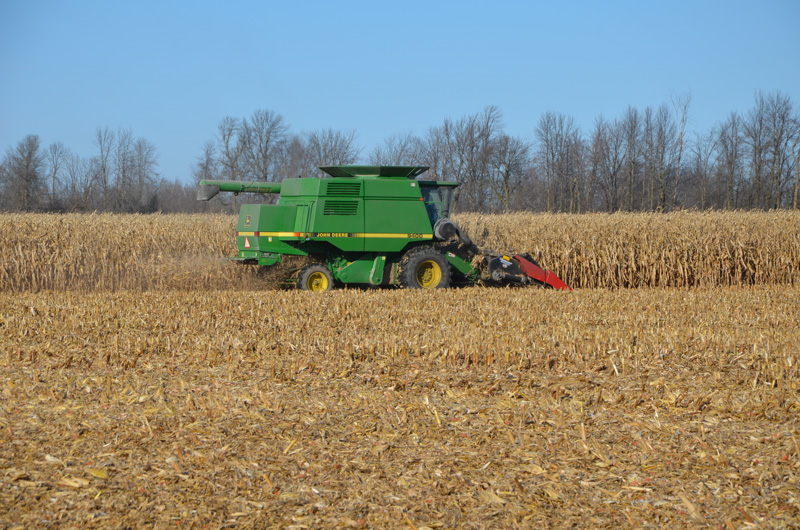Combining at full throttle
Due to the growing season affected by rain, some lasting impacts are still visible as the corn is coming off the fields, according to OMAFRA Cropping Systems Specialist Scott Banks. As the growing season ends, farmers have been taking advantage of the few dry sunny days left in the season in another race against weather changes. Carruthers photo
by Michelle O’Donohue
AgriNews Contributor
CHESTERVILLE – With harvest in Ontario winding down for 2017, AgriNews reached out to OMAFRA Cropping Systems Specialist Scott Banks for an update on how harvest has progressed thus far, the planting of winter wheat and cover crops, and what remains to be done heading into our snowy season.

Vetter photo
When asked about the status of harvest 2017, Banks remarked that it has “progressed fairly well,” noting that several growers have completed their harvest for the year, “but there’s still quite a good chunk of corn out there yet.”
The weather, as always, has played a large role in this year’s harvest season. Banks noted that weather “earlier on, back in September is what really finished the crop in terms of maturity.” Continuing, he said, “Generally the harvest weather has been fairly good for getting the corn off… the recent snow that we’re getting just now [mid November] could delay a bit of harvesting.”
As much of this year’s growing season was affected by rain, some lasting impacts are still visible as the corn is coming off. Banks noted, “In some cases, we are seeing a bit of lodging of corn.” He explained that one of the possible causes for this may have been corn planted later in the season that perhaps had not reached full maturity, and was more susceptible to “standability” issues.
When commenting on the moisture levels of the corn coming out of the field, Banks remarked that corn is, “coming off at reasonable moistures, but requiring some drying at least.” He went on to note, “some of the later corn has been a little wetter than some of the earlier stuff because it was later maturing.”
Banks advised, the final corn yield amounts are “looking quiet variable,” stating “most growers have been reasonably pleased with the yield.” He went on to say that this is particularly true for corn that could be planted early. Noting that conversely, in other fields, there was an indication that the yield may be low this year right from the beginning, due to late planting time, coupled with wet conditions. He concluded by noting that overall the variability in yield was “somewhat expected given the tough start in the year.”
Commenting on test weights, Banks advised that so far results have been, “reasonably good, nothing stellar.” When asked about the corn toxin levels present this year, Banks referred to a Ministry of Agriculture survey completed this year on mycotoxins, noting the overall findings indicated, “mycotoxin levels are down a fair bit from last year… maybe slightly higher than the year before.” He went on to discuss the challenges in predicting toxins, noting, “with toxins in general, it’s hard to predict whether they are going to be a problem or not.” He advised that due to this variability, the recommendation to growers is to have grain samples tested, especially if you are feeding, and to have samples tested, “more than once, because it does vary within each field, from field to field, and time to harvest.”
Moving away from harvest to discuss fall planting, Banks noted the following about this year’s winter wheat acres, “the thought was because it had been such a wet year… we may see a drop in winter wheat acres, but we’re probably not too far off our normal.” He went on to say that the stretch of fair weather in September and October helped with soybeans coming off in “reasonably good time” allowing growers the option of planting winter wheat. While he did not have official statistics, he thought there could be “probably a slight increase in winter wheat acres going in this fall.”
When asked about cover crop popularity this year, Banks commented that overall there has been, “building interest in cover crops over the last few years.” Remarking that many view winter wheat as a “cover crop and a potential crop.” Despite the growing interest, Banks noted that aside from winter wheat, “most growers didn’t have as much opportunity to put a cover crop in as maybe other years.” Noting that it was difficult to determine if there were more cover crop acres planted this fall, remarking overall it was likely similar to the last few years.
The Ontario Cereals Crop Committee (OCCC) has released the 2018 Spring Cereals Report on their website. This report joins the winter wheat results that were posted in August. To view the report, visit the OCCC website at www.gocereals.ca. The report can be downloaded from the home page, and additional information can be found under the performance heading, divided into spring wheat, barley, and oats categories. Under each heading, results are available for different geographical areas across Ontario. Historical reports are also available, dating back to 2000 for winter wheat, and 2004 for spring cereals. Banks advised that these reports could be used as a tool for growers to “use to help pick which variety they want to grow next year.”













